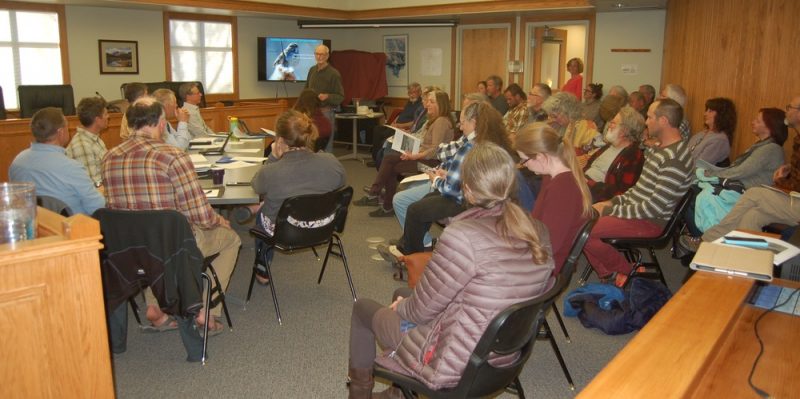The prophets of a brave new world, captains of industry
Have visions grand and great designs, but none have room for me…
— ‘Honest Work’ Todd Rungren, 1985
The Pagosa Springs Town Council held an interesting work session last night, focused on two (perhaps related?) topics. The first 45 minutes of the two-hour meeting consisted of a presentation by the local chapter of the Audubon Society, with information provided by Bob LeCour, Jean Zirnhelt, Randy McCormick, Barry Knot, and Keith Bruno, focused on the unique nature of the San Juan River wetlands located just south and east of the Springs Resort. This wetlands serves as both as a home to creatures year-round, and as a stop-over for migrating birds and other animals, thanks in part to the warm water flowing into the system from Pagosa’s underground geothermal aquifer. The Society is concerned about the health of the wetlands and its wildlife communities, due to a recent proposal by the owners of the Springs Resort to create a $180 million resort development directly adjacent to the wetlands.
The Council meeting room was about as fully packed as I have seen it, in my 16 years writing about local politics.

The presenters shared some fascinating information, which I hope to cover in more detail in a future editorial.
The rest of the work session dealt with STRs… Short Term Rentals… the growing, Internet-driven vacation rental industry that’s been turning hundreds of residential homes into mini-hotels, and changing quiet neighborhoods into lodging districts. The Town government recently began tracking and collecting registration fees from the STRs within the town limits, and Town Manager Andrea Phillips stated that about 10 percent of our downtown housing has been converted into mini-hotels. About 85 percent of the housing in the community, however, is located outside the town limits in the unincorporated county. Ms. Phillips told the Council she doesn’t have exact numbers for STRs in the county. Maybe 400? Maybe 800?
I’ve previously shared some of my own research into that question. Based on the vacation rentals listed on the Tripping.com website, it looks like we might have around 1,893 vacation rentals in the community. (See the number shown in the top left corner of the screen shot below…)

I’ll share some of the vacation rental conversation that took place at last night’s work session in a separate editorial, later on, as well.
These two topics — wildlife in the wetlands threatened by a resort development, and mini-hotels spreading across the suburban landscape and altering neighborhoods — might not seem related at first glance. But they’ve both arisen due to an ongoing, decades-long commitment to making Pagosa Springs into a tourist destination.
But right now, I want to finish this serial essay about the Chairlift to Heaven. I mention these two political conversations because they’re part of the Chairlift Effect — an experience where we’re being shuttled towards some destination… and we seem to have no control of the ride… and there’s no way to get off.
In Part One and Two, we considered the direction our nation — and the rest of the world — is headed, and the people who want to claim credit for the positive developments but who never want to take responsibility when things go wrong. When the economy is doing great, the captains of industry and the prophets of a brave new world step up to the microphone, waving, and tell us, “You’re welcome! Mention me to your friends.”
When we point to ongoing suffering, or slow economic disaster, the same leaders give a shrug. “Nothing we could do about it. It was beyond our control.”
I would suggest that almost all of it is beyond our control. We’re on the Chairlift to Heaven.
Or… are we?
I enjoyed writing about EVs — electric vehicles — in a recent six-part editorial series, mostly because I knew so little about the subject, so the learning curve was slightly exhilarating. I still know very little about the topic. But I find it fascinating to watch our local leaders following their noses as they consider ways to “improve” our community.
The subject came to the foreground earlier this month when a representative from ChargePoint rolled out a Power Point presentation for the Town Council, proposing that local taxpayers ought to help fund a new “fast charging” Tier Two electric car charging station in Centennial Park. The Colorado state government, under the leadership of Governor Jared Polis, stepped up to the climate change plate and dedicated $10 million in grant funds to help companies like ChargePoint connect with taxpayers and build out dozens of EV charging stations up and down Colorado, to promote the electric revolution.

Apparently, the revolution is already here, and some folks — like ChargePoint, Inc. — have become obsessed with making the transition easy. As a result, we will soon be able to leave our vehicles at a charging station and walk to wherever we’re going, holding our cell phones in our hands, with a laptop tucked under our arm.
Smiling and strolling the sidewalks while your vehicle gets charged.
We must admit the picture is at least as pleasant as standing at a gas pump, filling the tank with a mixture of hydrocarbons that will pollute our air and water… even if the re-fueling might take less time. But…
Gasoline cars. Electric cars. Both pictures depend upon this:

Some of our Daily Post readers might agree, that this is not the outcome any of us want when we imagine the future of our little mountain town.
A couple of years ago, urban planning guru Richard Florida wrote an article for CityLab.com
“Parking Has Eaten American Cities”
Parking eats up an incredible amount of space and costs America’s cities an extraordinary amount of money. That’s the main takeaway of a new study that looks in detail at parking in five U.S. cities: New York, Philadelphia, Seattle, Des Moines, and Jackson, Wyoming.
The study, by Eric Scharnhorst of the Research Institute for Housing America (which is affiliated with the Mortgage Bankers of America), uses data from satellite images, the U.S. Census, property tax assessment offices, city departments of transportation, parking authorities, and geospatial maps like Google Maps to generate inventories of parking for these five cities.
You can download that fascinating study here.
